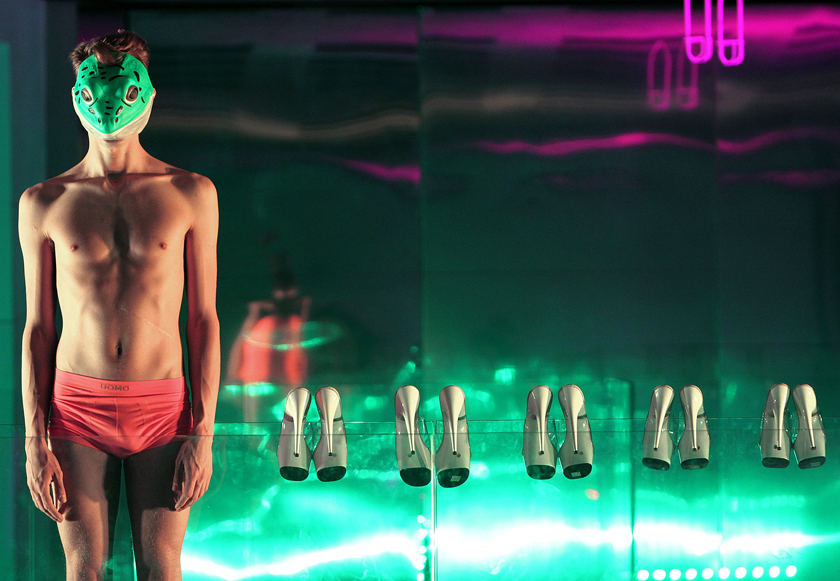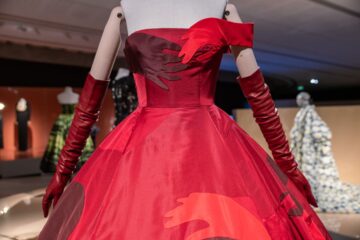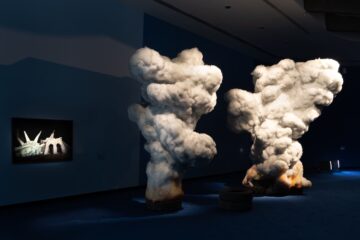SOME DISORDERED CHRISTMAS INTERIOR GEOMETRIES – FONDAZIONE ALDA FENDI BY RICCI/FORTE – ROME

Some Disordered Christmas Interiors Geometries
Compagni Ricci/Forte
FONDAZIONE ALDA FENDI – ESPERIMENTI
Roma – Foro Traiano, 1 – www.fondazionealdafendi.it
Text by Roberta d’Errico
It has been played out Ricci/Forte’s latest ideation, the nationwide première “Some Disordered Christmas Interiors Geometries” at Foro Traiano’s Silo from 08 on to 15 December 2010. It is the site where the Fondazione Fendi – Esperimenti (Experiments – Fendi’s Foundation) brings forth the artistic and cultural projects since 2001. The characteristic feature of company is a miscellany of different artistic languages. The performance of nearly 45 minutes got 8 re-enactments a day for a limited numbers of spectators.
“A sole event that will not be re-enacted ever after this occasion”, the press release says. Hence the necessity to tell the narrative we have had the privilege to watch.
The performance begins before entrance when the public is steered to the ambulance where the reservation is confirmed and a weird nurse stamps on the back of our hand a Christmas Tree.
The threshold of everyday life is crossed. We have stepped inside the uncertainty of incredibility now.
At the entrance of Silo we are welcomed by a scenario that recalls the space ambience.
The actors, men and women, are dressed as nurses and wear extravagant very high-heeled white shoes. The ultraviolet lights phosphoresce the white coats and clothing. The actors walk among the public with languid and slow attitude. Their eyes look for spectator’ to symbiose: they brush and whisper to our ears some sentences that introduce to the meaning of the enactment: sorrowful considerations about Genoa 2001, immaterial and sibylline messages prepare the audience to a concerted perceptive dimension.
Some actors employ the salver as a mirror to put in front of us and we don’t know whether to watch or not much to our confusion. It can happen a living collage is created by joining our reflection to a part of the person’s face that hands out the mirror. On one side of the hall we find a font filled of milk and some nurses top up some full glass always offered to some privileged spectators. It seems a purification rite where the milk is not a symbol of sin although it echoes Fellini’s episode of Boccaccio 70 but prepares the audience to watch the second half of the performance just as a magic potion. The progression is drastically marked by actors’ unexpected gestures that announce their metamorphosis into the nakedness through their movements hinting at the difficulty and uneasiness of the passage. Males and females were left with underclothes on. The spectators are ushered into another Silo’s room.
Along the path each actor looks after a group of spectators to whom he tells his Christmas days, some reminiscences, of aunt recipes, say of poems by heart, the warmth of friendship…
Passing through a room on one side we watch the pictures of actors’ faces hung on the wall with great accuracy and on the ground, on the other side, different same copies of Christmas cards with an old-aged flavour, and at last some small television sets reminding us our Christmas’ is passing through the screen.
The latest room recalls a Dantesque limbo which takes in strong breathes of hell. Crossing a footway the spectator is ushered towards what will be in the end his point of view. The most enthralling scenery and perhaps the easier to be decoded, is represented by the drip-feeds hanging from the ceiling. In this moment the perception is of great difficulties for the audience. The spectator due to the cramped space reserved to him must exert himself at any time to see and watch the action on the stage. The wall the spectator has in front of him is an opaque and reflecting foil which gives back the deformed image creating over again an aura of Symbolism and Expressionism. An actress in front of the wall but facing us expresses the adversities of life speaking into a microphone.
At the same time the actors standing on the footway are engaged in a frenzied fight to pass over the glass and to gain the central space. Their bodies twist and hug spasmodically to the glass in the attempt to go past it. The latest frantic act is to put on the glass the pictures of their faces which superimpose on top of their own, living the body in human solitude. Two actors take turns by letter, even if they are aware that it won’t be ever read, to express the wish to Santa Claus that the mankind could regain possession of their true values.
It is for such a reason perhaps, that three actors rush to get inside the futuristic cages put on the sides of the stage and two or three others take possession of main central room and start to twist frantically themselves round the rope of drip-feed. At the same time an actor tries to reel his own body in a silver paper. Two different gestures whose purpose is the same seemingly: to hide his own body as a pupa to come back on a new life. Nevertheless the resurrection is failed.
Shortly afterwards the actors start to cut the drip ply by scissors and even the actor by the looks happy in his silver wrap must free himself. He undresses and almost mechanically spreads his head with the fluid of a drip. Two actors male and female, walk up to him and drink from his body like vampires hungry for life. The actor whose role is to identify himself as a saviour apparently sobs desperately. That cry is the sorrowful acceptance of knowing that he shall give his own flesh and blood away.
The work has been created for a specific site. The lay-out has been intriguing and with reluctance I found out that the performance was over and I had to walk out that place where almost without realizing it I recovered the lost feeling for Christmas, although all facts have been devised to mess up the Christmas: the thinking of our own being, the reflections about the world and the transcendence.
Roberta d’Errico
into English by Salvatore Rollo at salvatore_rollo@fastwebnet.it
.
Testo di Roberta D’Errico
Dall’8 al 15 dicembre 2010, presso il Silos del Foro di Traiano, sede dal 2001 dei progetti artistici e culturali della Fondazione Fendi – Esperimenti, si è svolta, in prima nazionale, la performance Some Disordered Christmas Interiors Geometries, ultima ideazione della Compagnia Ricci/Forte.
Nota caratterizzante della compagnia è la miscidanza di diversi linguaggi artistici. Lo spettacolo, dalla durata di circa quarantacinque minuti, ha avuto ogni giorno otto repliche per un numero limitato di spettatori.
“Un evento unico, che non sarà mai più replicato dopo questa occasione” recita il comunicato stampa. Da qui l’esigenza di riportare la narrazione scenica a cui abbiamo avuto il privilegio di assistere.
Lo spettacolo inizia prima dell’ingresso, quando il pubblico è indirizzato verso un’ambulanza, dove dopo la conferma della prenotazione, un’eccentrica infermiera mette sul dorso della nostra mano un timbro a forma di albero di Natale. La soglia del quotidiano è varcata, siamo ormai entrati nella sospensione dell’incredulità.
All’ingresso del Silos troviamo uno scenario che richiama atmosfere spaziali.
Gli attori, uomini e donne, sono vestiti da infermiere con eccentriche scarpe bianche dai tacchi altissimi. Le luci ultraviolette rendono fosforescente il bianco dei camici e degli abiti. Gli attori camminano languidamente e lentamente tra gli spettatori. Cercano con lo sguardo il richiamo magnetico dello spettatore con cui entrare in simbiosi: sfiorano e sussurrano all’orecchio di noi spettatori frasi che introducono al senso della rappresentazione: dolorose considerazioni su Genova 2001, astratti e sibillini messaggi, dispongono lo spettatore verso una dimensione percettiva profonda.
Alcuni attori utilizzano il vassoio come specchio da porgere di fronte al nostro volto e, imbarazzati, non sappiamo se osservarci. Può accadere di creare un collage vivente unendo il proprio volto riflesso ad una porzione di volto di chi ci porge lo specchio. Ad un lato della sala, vi è una fonte colma di latte e delle infermiere riempiono dei bicchieri che vengono offerti sempre a privilegiati spettatori. Sembra un rito di purificazione dove il latte, benché riecheggi la colonna sonora dell’episodio girato da Fellini per Boccaccio ’70, non è simbolo di peccato, ma, come una pozione magica, rende lo spettatore pronto ad assistere alla seconda parte della performance.
Il passaggio è drasticamente marcato da improvvisi gesti degli attori che annunciano la loro metamorfosi con movimenti allusivi alla difficoltà e al disagio del passaggio verso la nudità. Rimangono corpi di uomini e di donne vestiti di lingerie. Si viene accompagnati in un’altra sala del Silos.
Nel percorso ogni attore si prende cura di un gruppo di spettatori a cui racconta il suo Natale di ricordi, di ricette delle zie, le poesie recitate a memoria, il calore della compagnia…
In una sala di passaggio si osservano da un lato, le foto dei volti degli attori appese al muro con geometrica precisione, dall’altro, per terra, diverse identiche copie di bigliettini di Natale di sapore antico, e infine dei piccoli televisori che ci ricordano che il nostro Natale passa attraverso lo schermo.
L’ultima sala richiama un limbo dantesco, che ha forte il respiro dell’Inferno. Attraverso una passerella, lo spettatore viene condotto in quello che da qui fino alla fine sarà il suo punto di vista. L’elemento scenico più suggestivo, e forse di più semplice decodificazione, è rappresentato dalle flebo che pendono dal soffitto. E’ questo il momento di più difficile percezione per lo spettatore. Questi, dato l’angusto spazio a lui riservato, ogni istante si deve affannare per infilare lo sguardo ed osservare l’azione scenica.
La parete che lo spettatore si trova di fronte è una lamina opaca e specchiante che restituisce l’immagine deformata ricreando così atmosfere simboliste ed espressioniste. Un’attrice posta di fronte a tale parete ma rivolta verso di noi, parla al microfono ed esprime il male del vivere.
Contemporaneamente, gli attori rimasti sulla passerella sono impegnati in una frenetica lotta per scavalcare il vetro e conquistare lo spazio centrale. I loro corpi si contorcono e aderiscono spasmodicamente al vetro nel tentativo di oltrepassarlo. L’ultimo atto disperato è quello di posare sulla superficie del vetro la foto del loro volto che si sovrappone al loro lasciando il corpo nella solitudine umana. A turno, due attori, esprimono il desiderio di un ritorno dell’umanità a valori autentici in una lettera a Babbo Natale recitata con la consapevolezza che non verrà mai letta.
E’ per questo, forse, che tre attori corrono ad infilarsi in futuristiche gabbie poste ai lati dell’ambiente scenico e altri due o tre prendono possesso dello spazio centrale della sala ed iniziano ad attorcigliarsi freneticamente nel filo della flebo. Contemporaneamente, un attore tenta di avvolgere il proprio corpo con carta argentata. Due gestualità diverse il cui obiettivo sembra lo stesso: celare il proprio corpo come una crisalide per risorgere a nuova vita. Ma la resurrezione è fallita.
Poco dopo, gli attori cominciano a tagliare con delle forbici il filo della flebo ed anche l’attore che sembrava felice del suo involucro argenteo, deve liberarsi. Quasi meccanicamente, si cosparge il capo con il siero di una flebo e si denuda completamente. Due attori, un uomo ed una donna, si avvicinano a lui e bevono dal suo corpo, assetati di vita, come vampiri. L’attore, il cui ruolo sembra identificarsi con quello di un salvatore, piange disperatamente. Quel pianto è l’accettazione dolorosa di chi sa di dover donare se stesso e la propria carne.
L’opera teatrale è stata concepita per uno specific site. L’impaginazione è stata coinvolgente e malvolentieri ho appreso che la performance era terminata e che dovevo abbandonare quel luogo dove, benché ogni elemento fosse stato costruito per sovvertire il Natale, quasi senza accorgermene avevo ritrovato il perduto senso del Natale: la riflessione su sé stessi, sul mondo e sulla trascendenza.
Roberta d’Errico






No Comment